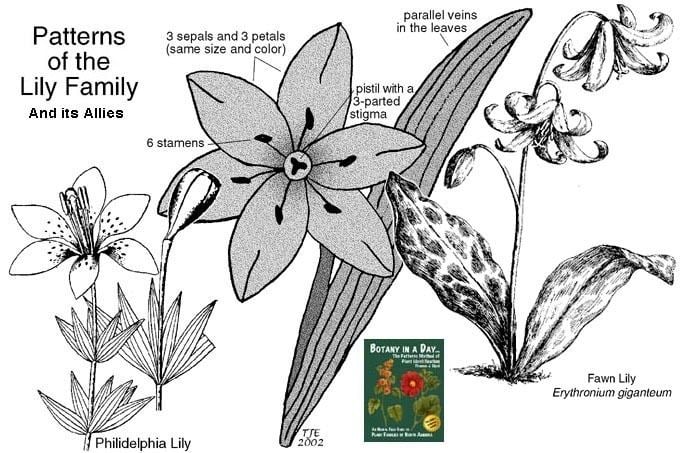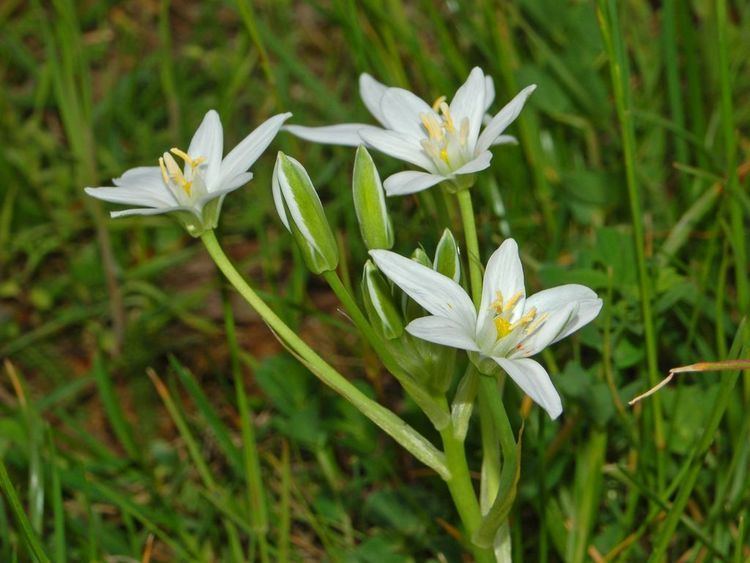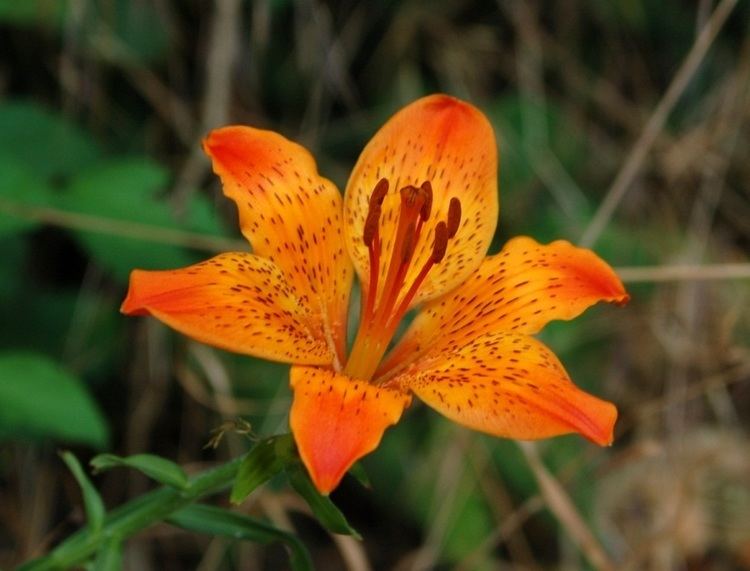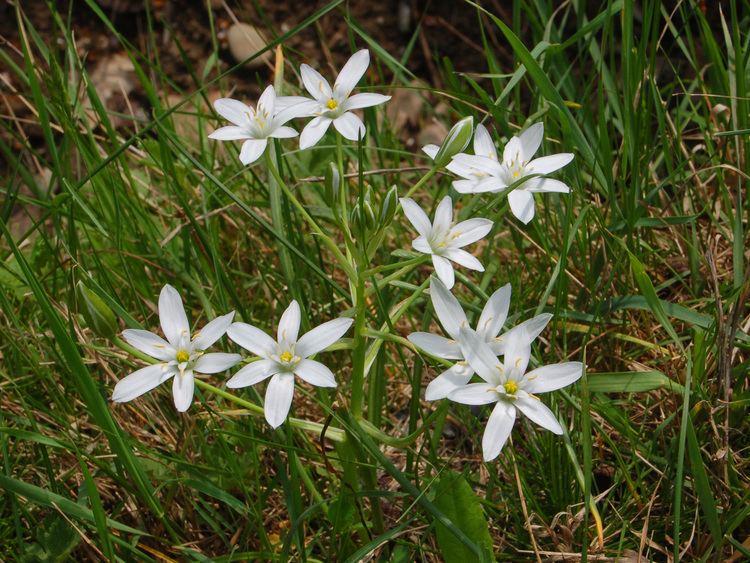Superorder Lilianae Scientific name Liliaceae | ||
 | ||
Lower classifications Lily, Tulip, Fritillaries, Erythronium, Gagea | ||
The lily family, Liliaceae, consists of fifteen genera and about 705 known species (Christenhusz & Byng 2016 ) of flowering plants within the order Liliales. They are monocotyledonous, perennial, herbaceous, often bulbous geophytes. Plants in this family have evolved with a fair amount of morphological Diversity despite genetic similarity. Common characteristics include large flowers with parts arranged in threes: with six colored or patterned petaloid tepals (undifferentiated petals and sepals) arranged in two whorls, six stamens and a superior ovary. The leaves are linear in shape, with their veins usually arranged parallel to the edges, single and arranged alternating on the stem, or in a rosette at the base. Most species are grown from bulbs, although some have rhizomes. First described in 1789, the lily family became a paraphyletic "catch-all" group of petaloid Monocots that did not fit into other families and included a great number of genera now included in other families and in some cases in other orders. Consequently, many sources and descriptions labelled "Liliaceae" deal with the broader sense of the family.
Contents
- Liliaceae family flower
- Description
- General
- Specific
- Taxonomy
- History
- Modern APG classification and phylogeny
- Evolution and biogeography
- Suprageneric subdivisions
- Genera
- Etymology and pronunciation
- Distribution and habitat
- Ecology
- Pests and predators
- Floriculture
- Tulips
- Lilies
- Other
- Propagation
- Sexual reproduction
- Asexual reproduction
- Toxicology
- Uses
- Fleur de lis
- References

The family evolved approximately 52 million years ago during the Late Cretaceous to Early Paleogene eras. Liliaceae are widely distributed, mainly in temperate regions of the Northern Hemisphere and the flowers are insect pollinated. Many Liliaceae are important ornamental plants, widely grown for their attractive flowers and involved in a major floriculture of cut flowers and dry bulbs. Some species are poisonous if eaten and can have adverse health effects in humans and household pets.

A number of Liliaceae genera are popular cultivated plants in private and public spaces. Lilies and tulips in particular have had considerable symbolic and decorative value, and appear frequently in paintings and the decorative arts. They are also an economically important product.

Liliaceae family flower
Description

The diversity of characteristics complicates any description of the Liliaceae morphology, and confused taxonomic classification for centuries. The diversity is also of considerable evolutionary significance, as some members emerged from shaded areas and adapted to a more open environment (see Evolution).
General

The Liliaceae are characterised as monocotyledonous, perennial, herbaceous, bulbous (or rhizomatous in the case of Medeoleae) flowering plants with simple trichomes (root hairs) and contractile roots. The flowers may be arranged (Inflorescence) along the stem, developing from the base, or as a single flower at the tip of the stem, or as a cluster of flowers. They contain both male (androecium) and female (Gynoecium) characteristics and are symmetric radially, but sometimes as a mirror image. Most flowers are large and colourful, except for Medeoleae. Both the petals and sepals are usually similar and appear as two concentric groups (whorls) of 'petals', that are often striped or multi-coloured, and produce Nectar at their bases. The stamens are usually in two groups of three (trimerous) and the pollen has a single groove (monosulcate). The ovary is placed above the attachment of the other parts (superior). There are three fused carpels (syncarpus) with one to three chambers (locules), a single style and a three-lobed Stigma. The embryo sac is of the Fritillaria type. The Fruit is generally a wind dispersed capsule, but occasionally a berry (Medeoleae) which is dispersed by animals. The leaves are generally simple and elongated with veins parallel to the edges, arranged singly and alternating on the stem, but may form a rosette at the base of the stem.
Specific
Characteristics often vary by habitat, between shade-dwelling genera (such as Prosartes, Tricyrtis, Cardiocrinum, Clintonia, Medeola, Prosartes, and Scoliopus) and sun loving genera. Shade-dwelling genera usually have broader leaves with smooth edges and net venation, and fleshy fruits (berries) with animal-dispersed seeds, rhizomes, and small, inconspicuous flowers while genera native to sunny habitats usually have narrow, parallel-veined leaves, capsular fruits with wind-dispersed seeds, bulbs, and large, visually conspicuous flowers. (See also Evolution).
Taxonomy
The taxonomy of the Liliaceae has a very complex history. The family was first described in the eighteenth century, and over time many other genera were added until it became one of the largest of the monocotyledon families, and also extremely diverse. Modern taxonomic systems, such as the APG which is based on phylogenetic principles using molecular biology, have redistributed many of these genera resulting in the relatively small family that is currently recognised. Consequently, there are many different accounts of the Liliaceae in the literature and older uses of the term occur commonly. To distinguish between them, the Latin terms sensu lato and sensu stricto are frequently used (together with their abbreviations, S.l. and s.s.) to denote the broader or stricter sense of the circumscription respectively, e.g. Liliaceae s.s..
History
The Liliaceae family was described by Michel Adanson in 1763 and formally named by Antoine Laurent de Jussieu in 1789. Jussieu defined this grouping as having a calyx of six equal colored parts, six stamens, a superior ovary, single style, and a trilocular (three-chambered) capsule. By 1845, John Lindley, the first English systematist unhappily acknowledged the great diversity in the circumscription of the family, and that it had expanded vastly, with many subdivisions. As he saw it, the Liliaceae were already paraphyletic ("catch-all"), being all Liliales not included in the other orders, but hoped that the future would reveal some characteristic that would group them better. He recognized 133 genera and 1200 species. By the time of the next major British classification – that of Bentham and Hooker in 1883 (published in Latin) – several of Lindley's other families had already been absorbed into the Liliaceae. Over time the Liliaceae became increasingly broadly, and somewhat arbitrarily defined as all species of plants with six tepals and a superior ovary, eventually coming to encompass about 300 genera and 4,500 species, within the order Liliales in the Cronquist system (1981). Cronquist merged the Liliaceae with the Amaryllidaceae, making this one of the largest monocotyledon families.
Many other botanists echoed Lindley's earlier concerns about the phylogeny of the Liliaceae, but various schemes to divide the family gained little traction. Dahlgren (1985) suggested there were in fact forty – not one – families distributed over three orders (predominantly Liliales and Asparagales). In the context of a general review of the classification of angiosperms, the Liliaceae were subjected to more intense scrutiny. Considerable progress in plant phylogeny and phylogenetic theory enabled a phylogenetic tree to be constructed for all of the flowering plants, as elaborated by the Angiosperm Phylogeny Group (1998).
Modern APG classification and phylogeny
The Angiosperm Phylogeny Group (APG) made rapid progress in establishing a modern monophyletic classification of the flowering plants by 2009. Despite establishing this relative degree of monophyly (genetic homogeneity) for the Liliaceae family, their morphology remains diverse and there exists within the Liliaceae clade or grouping, a number of subclades (subgroups). Particularly enigmatic were Clintonia, Medeola, Scoliopus, and Tricyrtis.
Of the fifteen genera within the Liliaceae, the ten genera of the Lilioideae subfamily form one morphological group that is characterised by contractile bulbs and roots, and a Fritillaria-type embryo-sac (megagametophyte with four megaspores). Within the Lilioideae, Clintonia and the closely related Medeola form a subclade, and are now considered a separate tribe (Medeoleae). The other major grouping consists of the five genera constituting the Streptopoideae (including Scoliopus) and Calochortoideae (including Tricyrtis) subfamilies characterised by creeping rhizomes, styles which are divided at their apices, and by megagametophyte development of the Polygonum-type (a simple megaspore and triploid endosperm) embryo-sac.
Evolution and biogeography
The development of a phylogenetic approach to taxonomy suggested the Liliales formed some of the earliest monocots. Molecular analysis indicates that divergence amongst the Liliales probably occurred around 82 million years ago. The closest sister family to the Liliaceae are the Smilacaceae with the Liliaceae separating 52 million years ago. Liliaceae thus arose during the late (Maastrichtian) Cretaceous to early (Paleocene) Paleogene periods. Major evolutionary clades include the Lilieae (Lilium, Fritillaria, Nomocharis, Cardiocrinum, Notholirion) from the Himalayas about 12 mya and the Tulipeae (Erythronium, Tulipa, Gagea) from East Asia at about the same time. The Medeoleae (Clintonia and Medeola) may have appeared in North America but were subsequently dispersed, as may have the Streptopoideae and Calochortoideae. Liliaceae fossils have been dated to the Paleogene and Cretaceous eras in the Antarctic.
The Liliaceae probably arose as shade plants, with subsequent evolution to open areas including deciduous forest in the more open autumnal period, but then a return of some species (e.g. Cardiocrinum). This was accompanied by a shift from rhizomes to bulbs, to more showy flowers, the production of capsular fruit and narrower parallel-veined leaves. Again, some reversal to the broader reticulate-veined leaves occurred (e.g. Cardiocrinum)
Suprageneric subdivisions
Due to the diversity of the originally broadly defined Liliaceae s.l., many attempts have been made to form suprageneric classifications, e.g. subfamilies and tribes. Classifications published since the use of molecular methods in phylogenetics have taken a narrower view of the Liliaceae (Liliaceae s.s.). The Angiosperm Phylogeny Website (APWeb) recognizes three subfamilies, one of which is divided into two tribes.
Genera
Various authorities (e.g. ITIS 16, GRIN 27, WCSP, NCBI, DELTA ) differ on the exact number of genera included in Liliaceae s.s., but generally there are about fifteen to sixteen genera, depending on whether or not Amana is included in Tulipa and Lloydia in Gagea. For instance Amana is still listed separately in WCSP.
Currently the APWeb lists fifteen genera, arranged as shown in this table :
The largest genera are Gagea (200), Fritillaria (130), Lilium (110), and Tulipa (75 species), all within the Lilieae tribe.
Etymology and pronunciation
The name "Liliaceae" (English /ˌlɪliˈeɪsi, -siˌaɪ, -siˌeɪ, -siˌi/) comes to international scientific vocabulary from New Latin, from Lilium, the type genus, + -aceae, a standardized suffix for plant family names in modern taxonomy. The genus name comes from the Classical Latin word lilium, "lily", which in turn came from the Greek L.írion (λείριον).
Distribution and habitat
The Liliaceae are widely distributed, but mainly in the temperate regions of the Northern Hemisphere. The centre of diversity is from southwest Asia to China. Their distribution is diverse, mainly in plains, Steppes, and alpine meadows, but also in deciduous forests, Mediterranean scrub and arctic tundra. Tulipa and Gagea provide examples of ornamental geophyte biomorphological types representing continental thermoperiodic zones (Irano-Turanian region), characterised by cessation of underground growth at high temperatures in early summer and requiring low winter temperatures for spring flowering. While some genera are shade-dwelling, such as the Medeoleae, and Streptopoideae, Tricyrtis, and Cardiocrinum, others prefer a more open habitat.
Ecology
The Liliaceae are ecologically diverse. Species of Liliaceae bloom at various times from spring to late summer. The colorful flowers produce large amounts of nectar and pollen that attract insects which pollinate them (entomophily), particularly bees and wasps (hymenopterophily), butterflies (psychophily) and moths (phalaenophily). The seeds are dispersed by wind and water. Some species (e.g. Scoliopus, Erythronium and Gagea) have seeds with an aril structure that are dispersed by ants (myrmecochory).
Pests and predators
Liliaceae are subject to a wide variety of diseases and pests, including insects, such as thrips, aphids, beetles and flies. Also fungi, viruses and vertebrate animals such as mice and deer. An important horticultural and garden pest is the Scarlet lily beetle (Japanese red lily beetle, Lilioceris lilii) and other Lilioceris species which attack Fritillaria and Lilium. Lilium species may be food plants for the Cosmia trapezina moth. A major pest of Tulips is the fungus, Botrytis tulipae.
Both Lilium and Tulipa are susceptible to a group of five viruses of the Potyviridae family, specifically the potyvirus (named for potato virus Y) group, which includes the Tulip-breaking Virus TBV and the Lily streak virus (Lily mottle virus, LMoV) resulting in 'breaking' of the color of the flowers. The viruses are transmitted by aphids. This breaking effect was of economic importance during the tulip mania of the seventeenth century, because it appeared to be producing new varieties. In modern times tulip breeders have produced varieties that mimic the effect of the virus, without being infected. One of these varieties is known as 'Rembrandt', after the Dutch artist of that name. Contemporary tulip owners commonly had Rembrandt and other artists paint their flowers to preserve them for posterity, hence the 'broken' tulips were known as Rembrandt tulips at that time. Another modern variety is 'Princess Irene'. One of the tulip breaking viruses is also named the Rembrandt tulip-breaking virus (ReTBV).
Floriculture
Many species of Lilieae (in genera Tulipa, Fritillaria, Lilium, and Erythronium) and Calochortoideae (Calochortus and Tricyrtis) are grown as ornamental plants worldwide. Within these genera a wide range of cultivars have been developed by breeding and hybridisation. They are generally used in outdoor gardens and other displays, although in common with many bulbous flowering plants they are often induced to bloom indoors, particularly during the winter months. They also form a significant part of the cut flower market, in particular Tulipa and Lilium.
Tulips
Tulips have been cultivated since at least the tenth century in Persia. Tulip production has two main markets: cut flowers and bulb. The latter are used, in turn, to meet the demand for bulbs for parks, gardens and home use and, secondly, to provide the necessary bulbs for cut flower production. International trade in cut flowers has an approximate total value of 11 billion euros, which provides an indication of the economic importance of this activity. The main producer of tulip bulbs is the Netherlands, a country that accounts for 87% of the global cultivated area, with approximately 12,000 hectares. Other leading producers include Japan, France and Poland. Approximately ten other countries produce commercial tulips, largely for the domestic market. By contrast, the Netherlands is the leading international producer, to the extent of 4 billion bulbs per annum. Of these, 53% are used for the cut flower market and the remainder for the dry bulb market. Of the cut flowers, 57% are used for the domestic market in the Netherlands and the remainder exported.
Original Tulipa species can be obtained for ornamental purposes, such as Tulipa tarda and Tulipa turkestanica. These are referred to as species, or botanical, tulips, and tend to be smaller plants but better at naturalising than the cultivated forms. Breeding programs have produced a wide range of tulip types, enabling blooming through a much longer season by creating early, mid- and late spring varieties. Fourteen distinct types are available in addition to botanical tulips, including Lily-flowered, Fringed, Viridiflora and Rembrandt. In addition to blooming season, tulip varieties differ in shape, and height, and exhibit a wide range of colours, both pure and in combination.
Lilies
The largest area of production is also the Netherland, with 76% of the global cultivated area, followed by France, Chile, Japan, the United States, New Zealand and Australia. Approximately ten countries produce lilies commercially altogether. About half of the commercial production is for cut flowers. Many of these countries export bulbs as well as supplying the domestic market. The Netherland produces about 2,200 million lily bulbs annually, of which 96% is used domestically and the remainder exported, principally within the European Union. One particularly important crop is the production of Lilium longiflorum, whose white flowers are associated with purity and Easter.
Although many Lilium species such as Lilium martagon and Lilium candidum can be obtained commercially, the majority of commercially available lilies represent the products of a very diverse hybridisation program, which has resulted in a separate horticultural classification, including such groupings as Asian, Oriental and Orienpet. In addition to a very wide variety of heights, lilies can be obtained in many colours and combinations of colours, and if properly selected can produce an extensive blooming season from early summer to autumn. Because of the history of Liliaceae, many species such as Watsonia (bugle lily) that were previously classified in this family bear the name 'lily' but are neither part of the genus Lilium, or the Liliaceae family.
Other
A variety of Fritillaria species are used as early spring ornamental flowers. These vary from the large Fritillaria imperialis (crown imperial) available in a number of colours such as yellow or orange, to the relatively tiny species such as Fritillaria meleagris or Fritillaria uva-vulpis with their chequered patterns. Erythronium is less common but a popular cultivar is 'Pagoda' with its sulphur yellow flowers. Calochortus (mariposa lily) may be sold as a mixture or as cultivars.
Propagation
Methods of propagation include both sexual and asexual reproduction. Commercial cultivars are usually sterile.
Sexual reproduction
Seeds can be used for propagation of the plant or to create hybrids and can take five to eight years to produce flowering plants. Since interspecific cross-pollination occurs, overlapping wild populations can create natural hybrids.
Asexual reproduction
Bulb offsets and tissue culture produce genetic clones of the parent plant and thus maintaining genetic integrity of the cultivars. Bulb offsets usually require at least a year before flowering. Commercially, plants may be propagated in vitro and then planted out to grow into plants large enough to sell.
Toxicology
While members of the Liliaceae s.s. have been used as food sources in humans, the bulbs of some species are poisonous to household pets (bulb toxicosis) if eaten and may cause serious complications, such as renal failure in cats from Lilies, particularly Lilium longiflorum (Easter Lily). Dogs may develop less serious effects such as gastrointestinal problems and central nervous system depression. Most Fritillaria (e.g. Fritillaria imperialis, Fritillaria meleagris) bulbs contain poisonous neurotoxic alkaloids such as imperialin (peiminine), which may be deadly if ingested in quantity, while other species such as Fritillaria camschatcensis and Fritillaria affinis are edible. Tulips can cause skin irritation due to the presence of tuliposides and tulipalins, which are also found in the flowers, leaves and stems of Fritillaria. These are also toxic to a variety of animals.
Uses
Fritillaria extracts are used in traditional Chinese medicine under the name chuan bei mu, and in Latin, bulbus fritillariae cirrhosae. The bulbs of Fritillaria roylei have been used as antipyretics and expectorants. Lilium bulbs, particularly Lanzhou lily (Lilium davidii) are used as food in China and other parts of Asia. During World War II, starvation conditions in the Netherlands (Hongerwinter, hunger winter 1944) led to using Tulipa bulbs as food. Calochortus bulbs were eaten by Native Americans and by the Mormon settlers in Utah during starvation. Other members of the family used for food include Clintonia (leaves), Medeola (roots), Erythronium (corms), and Fritillaria (bulbs).
Lilies
The Type genus, Lily (Lilium), has a long history in literature and art, and a tradition of symbolism as well as becoming a popular female name, and a floral emblem, particularly of France (fleur-de-lis). The cultivation of lilies has been described since at least the ninth century, when Charlemagne ordered it to be grown at his imperial palaces. However, the name 'lily' has historically been applied to a wide variety of plants other than the Lilium genus.
The lily appears in ancient literature associated with both sovereignty and virginal innocence, and is mentioned on a number of occasions in the Bible, such as the description in Solomon's Song of Songs (2, 1–2) "I am a rose of Sharon, a lily of the valleys. Like a lily among thorns is my darling among the young women" or the Gospel of Mathew (6, 28) "Consider the lilies of the field, how they grow; they toil not, neither do they spin" to represent beauty. Artistic representations can be found as far back as frescos from the second century BC, at Amnisos and Knossos. Early Christian churches, such as that of the Basilica of Sant' Apollinare in Classe were sometimes decorated with lilies. While predominantly depicted as white, those seen at Akrotiri are red lilies. The white lily has long been seen as a symbol of purity, coming to be associated with the Virgin Mary in the Middle Ages, from which came the name ‘Madonna lily’ (Lilium candidum). A well-known example is Leonardo da Vinci's Annunciation (1472–1475) in which the archangel Gabriel bears a Madonna lily. Other symbolic meanings include glory, love and birth.
Fleur-de-lis
The stylised lily, or fleur-de-lis (lily flower) has long been associated with royalty, although it may originally have been derived from the form of an iris. It has also been associated with the head of a spear. Its three parts have been associated with the three classes of mediaeval society, or alternatively faith, wisdom and chivalry. Whatever its exact derivation, it has come to be associated with France and the French monarchy since the earliest Frankish kings. Consequently, it became incorporated into not only French heraldry but also that of many heraldic devices in jurisdictions where there had been historic French influence, such as Quebec and New Orleans. In modern times it appears in many forms, symbolic and decorative, and can be used on compasses to indicate the direction north, as well as the Scouting movement.
Tulips
Tulips (Tulipa) also have a long cultural tradition, particularly in the Islamic world. The Persian word for tulips, L.leh (لاله), was borrowed into Turkish and Arabic as lale. In Arabic letters, lale is written with the same letters as Allah, and is used to denote God symbolically. Tulips became widely used in decorative motifs on tiles, fabrics, and ceramics in Islamic art and the Ottoman Empire in particular, and were revered in poetry, such as that of Omar Khayan in the twelfth century.
Tulips were an essential part of the gardens of Persia, having been cultivated from the Steppes. As the Seljuks – Oghuz-Turkic leaders originated from the steppes – moved to Persia, and then west, they took tulips with them to Turkey, where many escaped cultivation and became naturalised. Today there are a number of places in Turkey called Laleli (‘with tulips’). Tulips first appeared in the decorative arts in Turkey in the thirteenth century and flourished under the Ottomans, in particular in the royal palaces, and was adopted by the Osmans as their symbol. Further species were collected from Persia and the spreading Ottoman Empire saw to it that tulip culture also spread. By the sixteenth century it was a national symbol, hence the designation "Tulip era", by which time they were becoming of economic importance.
By 1562 the tulip trade had reached Europe with the first shipment to Antwerp, where they were mistaken for vegetables, although they had been cultivated in Portugal since 1530, and first appeared in illustration in 1559, and the first tulip flowers were seen in the Netherlands in 1625. Tulips spread rapidly across Europe in the seventeenth century, and became an important trading item, initially in France before concentrating in the Netherlands. Eventually speculative trading in tulips became so intense as to cause a financial bubble which eventually collapsed, a period known as tulip mania (tulipomania), from 1634 to 1637, similar to the Ottoman Empire's Tulip era.
Nevertheless, since then the tulip has become indelibly associated with the Netherlands and all things Dutch. it was during this period that the tulipiere, a Ceramic vase for growing tulips indoors was devised, and the Golden Age of Dutch Painting was replete with images of tulips. Although tulip festivals are held around the world in the spring, the most famous of these is the display at Keukenhof. One of the better-known novels on tulips is The Black Tulip by Alexandre Dumas, Père in 1850, dealing with a contest to grow a black tulip in late seventeenth-century Haarlem.
Other
Fritillaria are also often used as floral emblems, for instance as the county flower of Oxfordshire, UK. Calochortus nuttallii, the sego lily, is the official state flower of Utah.
